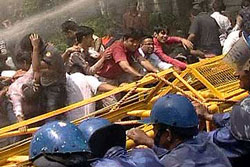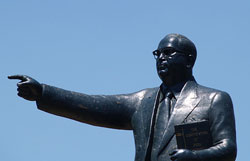Ilankai Tamil Sangam30th Year on the Web Association of Tamils of Sri Lanka in the USA |
|||
 Home Home Archives Archives |
The Roots of Dalit Rageby Sukumar Muralidharan, Himal, January, 2007
The symbolism of Dalit politics is a tactical response to the threat of violence lurking beneath the surface of Indian democracy. The benevolent tolerance that caste Hindu society affects may well be misplaced. In January 2006, Bant Singh, a Dalit peasant and community organiser, was assaulted near his home village in Mansa District of Punjab state. Left for dead by his assailants, he was denied attention at the district hospital, except on payment of an inducement that was plainly beyond his means. His condition deteriorated badly and three of his limbs had to be amputated when he was finally placed under competent medical care. Even as news of the shocking crime filtered out, there was little hint that the perpetrators, known to be two former headmen of Bant Singh’s village, would ever be brought to justice. In a zone where the liberties guaranteed by the Indian Constitution are little more than a phantasm, and the hierarchical privileges of caste and class the reality, Bant Singh had been punished for being found guilty of an unforgivable crime. He had shown faith in the rule of law, and sufficient persistence to fight a prolonged legal battle to bring to justice three men guilty of the sexual assault of his young daughter (See Himal October 2006, “The Dalit sword of Mansa”). In September, as Surekha Bhotmange prepared an evening meal for her family in Kherlanji village of Bhandara District in Maharashtra, a mob of local thugs broke into her house. She was dragged outside, along with her daughter Priyanka and two sons, Roshan and Sudhir, one of whom is visually handicapped. The women were lashed to a bullock cart and brutally gang-raped, before all four were murdered. Witnesses to the grisly carnage were sworn to secrecy. Their assent was easily secured, since they had just witnessed a crime that left few boundaries intact between observation and participation. Surekha’s husband Bhaiyyalal lived to tell the story, but his complaints at the local police station went unrecorded until the four charred bodies of the victims were discovered the following day. The Bhotmanges belonged to the Mahar caste of B R Ambedkar, and saw themselves as heirs to the great tradition of cultural rebellion that he represented. Their faith in the social mobility that education could bring, and their resistance to all efforts to snatch away part of their property for a water scheme that would bring them no conceivable benefit, was seen as a challenge to the casteist status quo. Like Bant Singh, they too fell victim to the alternative system of conflict resolution that prevails as the final bulwark of an ascriptive, hierarchical social order. When atrocities against the living remain unrequited, it might occasion some shock that supposed outrages against idols should provoke violence and calls for retribution. On 30 November, when news broke of a statue of B R Ambedkar being vandalised in Kanpur District of Uttar Pradesh, Dalit organisations mobilised for a day of protests. Violence was reported from diverse parts of the country, but the most demonstrative incidents were in Maharashtra, where one of the Indian Railways’ most prestigious commuter trains was set aflame between Bombay and Pune. Nobody was killed in the incident, though sporadic clashes elsewhere in the state did claim two lives. Symbolism over substance? Partly in response, a delicate compromise has been fashioned which places symbolism above substance. A statue of B R Ambedkar, installed at a prominent vantage point in the smallest town or village, is often regarded as a sufficient triumph – one that would sustain the solidarity of the movement, even as substantive gains remain elusive. It is this precise phenomenon that has led to a proliferation of statues of the man revered today as one of the great Indians of the 20th century. These rather hastily fashioned icons have proven offensive to the sensibilities of some, especially those with an ideological predilection towards the Hindutva strain of politics. What they fail to realise is that the iconography of Ambedkarism is a safety valve for the long-accumulated grievances of Dalit politics. Were this symbolism not available, the reaction of caste Hindu orthodoxy to the new Dalit assertion would go far beyond mere aesthetic distaste.
As journalist Jyoti Punwani wrote in a recent opinion piece, for all the significance of these anniversaries for the Dalits, it was as if they did not exist for the mainstream press. On 5 December, Punwani observes, a prominent newspaper in Bombay “carried on page one, pictures of two residents who live near Mumbai’s Shivaji Park, ready to leave home with bags packed”. They were leaving their homes temporarily because of the compelling need to “avoid the influx of Dalits to Shivaji Park on 6 December, Dr Ambedkar’s death anniversary”. It was not as if the residents of the area were strangers to large and disorderly gatherings. The Shiv Sena had been laying waste to their neighbourhood for at least 40 years during the Dussehra observances, charged by their leader Bal Thackeray’s oratory. In comparison, the annual assembly of Dalits on the occasion of Ambedkar’s death anniversary had invariably been a model of sobriety and civic responsibility. In the media narration again, the Kherlanji atrocity existed not as a brutal crime that called out for punitive sanctions, but as a looming presence that somehow enhanced the aura of menace hovering over the Ambedkar death anniversary observance. The media, Punwani argued, had shown admirable tenacity and commitment in holding the rather negligent system of justice to account for the deaths of Priyadarshini Mattoo and Jessica Lal – two young women of the urban middle class murdered by men who believed they enjoyed absolute impunity on account of their social circumstances. Priyanka Bhotmange’s was no less poignant a case, demanding as much if not more commitment on the part of the press. The reasons why Priyanka Bhotmange did not merit the same treatment as someone like Priyadarshini Mattoo are fairly clear. Shortly after the violent affrays over the vandalisation of an Ambedkar statue, a prominent English-language news channel ran an hour-long programme of debate and discussion centred on a single question: Are Dalits becoming pawns in a larger political game? Of the invited audience in the studio, 85 percent voted affirmatively, and among those who phoned in their responses, a still larger proportion concurred. It is difficult to avoid the suspicion that elite opinion – even in the upper- and middle-class strata that do not have reason to feel directly threatened by the assertive new strains in Dalit politics – tends to view the Dalits as a people who have not yet attained the political maturity to act on their own behalf. This perception, it seems, is derived from the elaborate symbolism of Dalit politics, particularly in relation to the iconography of Ambedkar. But in drawing the facile conclusion that Dalit politics is yet to attain maturity, elite opinion may well have mistaken contingent tactical adjustments with inherent characteristics. A recent report on the status of India’s Muslims, prepared by a commission headed by the eminent jurist Rajinder Sachar, pointed out that on several vital counts, India’s principal religious minority is perhaps as poorly off as the Dalits. But Dalit assertion, even if it has been met with violent reprisals every so often, has a legitimacy that the Muslim struggle for recognition has lacked, on account of the complex history of India’s nationalist movement. This is a narrative that includes, among other things, Ambedkar’s historic pact with Mahatma Gandhi and the Congress party in 1932, when the Muslim League and its leadership seemingly remained intent on underlining differences rather than shared interests. In later years, Ambedkar came to regret having yielded to Gandhi’s magnificent paternalism, but there is little question that the terms of the reconciliation between Dalits and caste Hinduism that he authored have provided a stable underpinning for the politics of independent India. It is also true that by making the assertion of identity an object in itself and consecrating the principle of unequal treatment under the law as a means of redressing centuries of institutionalised inequality, the Dalit compact has led to a peculiar brand of politics, where substantive interests and the pursuit of equality have often been subordinated to identity. It is unsurprising then, that the established order is able to respond to Dalit assertions of identity with a variety of tolerant benevolence, while the pursuit of substantive equality has been known to call forth extreme violence. Coercive focus This is a rather chastening reality. Under a political dispensation in which welfare commitments are professedly strong, the most powerful incentive in contesting elections should be to gain control over the welfare mechanisms – like health and education – rather than the apparatus of coercion. Substantive economic progress for the Dalits would presumably come from enhanced welfare expenditures, channelled through the social infrastructure. The reality in India, as manifest in the administrative actions of the BSP, seems the opposite. The overwhelming concern of a party of the oppressed, during its brief interludes in power in the largest state in the country, is not to augment welfare, but to capture the instruments of coercion. This seems to suggest two rather significant points about the Dalits’ social situation. The first is that under globalisation, the space for manoeuvre available – to increase welfare expenditure, for one – is becoming dangerously constricted. The second is that substantive progress through increased public spending on welfare sectors would only be possible if the instruments of coercion were to be taken over, or at the very least neutralised. Failing this, the coercive mechanisms of tradition would come into play, to overwhelm the Dalit pursuit of substantive equality. To be critical of the Dalits’ seeming disdain for constitutionalism and liberal democratic principles would be easy. But the experience of Uttar Pradesh – and indeed other parts of the country – is testimony to an undeniable fact. The rights of the oppressed may verbally be championed by various political formations eager to harvest their votes. But in a situation of direct confrontation between Dalit rights and entrenched privilege, the machinery of the state becomes an accessory of power and wealth. The ongoing litany of atrocities against Dalits, not to mention the failure of the apparatus of law and |
||
|
|||

 The months just passed witnessed two significant anniversaries connected with the man whose life-story has become a part of the lives and struggles of the Dalits of India. October 2006 saw the 50th anniversary of Ambedkar’s conversion to Buddhism. This conversion was a climactic act of cultural rebellion, and the fulfilment of a vow made in 1927 after a Satyagraha he led to assert Dalit rights to a water source invited the furious reprisals of upper-caste orthodoxy. A few weeks later, 6 December was the 50th anniversary of Ambedkar’s death.
The months just passed witnessed two significant anniversaries connected with the man whose life-story has become a part of the lives and struggles of the Dalits of India. October 2006 saw the 50th anniversary of Ambedkar’s conversion to Buddhism. This conversion was a climactic act of cultural rebellion, and the fulfilment of a vow made in 1927 after a Satyagraha he led to assert Dalit rights to a water source invited the furious reprisals of upper-caste orthodoxy. A few weeks later, 6 December was the 50th anniversary of Ambedkar’s death.